The Best AI Blog Post Generators (in 2025)
We tested dozens of AI blog generators to find the best tools that help you create, edit, and enhance blog posts quickly - saving you hours of writing time.
Creating fresh blog content consistently is one of the biggest challenges for busy professionals and marketing teams. AI blog post generators have transformed this process, helping content creators produce engaging articles in a fraction of the time.
After testing dozens of AI writing tools and analyzing their capabilities, we've identified the 8 most powerful blog post generators that deliver impressive results in 2025.
Quick look: The 8 best AI Blog Post Generators
 Writesonic Best for accelerating SEO contentSee Tool
Writesonic Best for accelerating SEO contentSee Tool Hypotenuse AI Best for E-commerce contentSee Tool
Hypotenuse AI Best for E-commerce contentSee Tool
What makes the best AI Blog Post Generators?
Here's what we evaluated to identify the top performers:
- Quality: The AI must generate clear, coherent, and engaging blog content. Top tools produce natural-sounding drafts that need minimal editing and avoid common AI pitfalls like repetition or generic phrasing.
- Customization: Leading platforms enable users to define and maintain brand voice through custom tones, style guides, and terminology settings. The ability to shape AI outputs to match specific content needs proved essential.
- Workflow: Evaluating how smoothly each tool integrates into content creation processes revealed major differences. The best options offer features like bulk generation, collaborative editing, and direct publishing to common platforms.
- Optimization: Top performers help create content that performs well in search results. Built-in SEO tools, keyword optimization, and content structure suggestions set the leading platforms apart.
The best AI Blog Post Generators at a glance
| Tool | Best For | Standout Features | Pricing |
|---|---|---|---|
| Japser | Maintaining Brand Voice | Customizable Brand Voice profiles. | Plans scale based on usage/features. |
| Anyword | Predicting Copy Performance | Predictive copy performance scores. | Premium plans for advanced features. |
| Writer | Governing Enterprise Content | Custom AI models enforce brand guidelines | Enterprise plans with custom per-seat pricing |
| Rytr | Writing Affordably | Fast, simple writing assistance. | Free tier plus affordable paid plans. |
| Writesonic | Accelerating SEO Content | Flexible AI quality modes. | Free trial, affordable quality-controlled plans. |
| Scalenut | Scaling SEO Content Production | Integrated SEO research and writing. | Plans start around $39/month. |
| Hypotenuse AI | E-commerce Content | Bulk product description generation. | Paid plans start around $29/month. |
| Copy AI | Iterating Marketing Copy | Iterative refinement loop for copy. | Free tier; paid plans start ~$36/month. |
Best AI Blog Post Generator for Maintaining Brand Voice
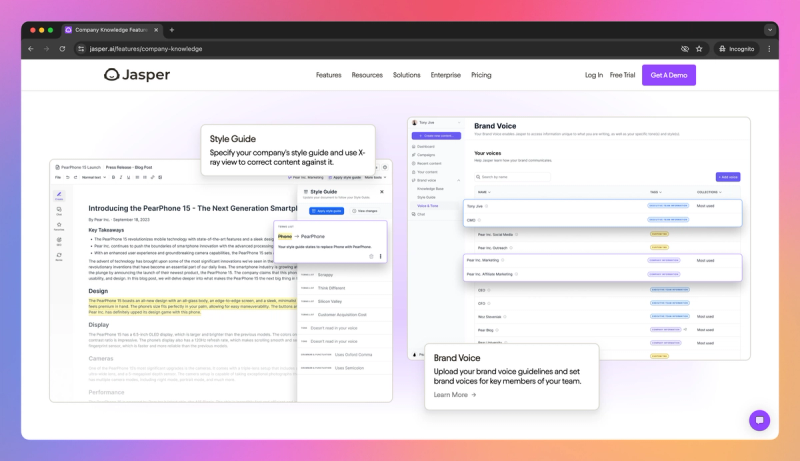
Jasper
Jasper (formerly Jarvis) is a widely adopted writing assistant recognized for its extensive features and marketing orientation. It helps generate blogs, marketing copy, and other materials while adhering to a specific brand voice. Its core strength is versatility and scalability for content teams, blending template-based help with advanced customization like tone and style profiles to ensure brand alignment. This tool proves especially powerful for marketing teams and content agencies requiring high-volume, consistent output across various channels like blogs, social media, and website content.
Pros:
- Content Quality & Consistency: Generate coherent, structured drafts that maintain a consistent tone once style guidelines are set, requiring minimal editing for long-form marketing content.
- Time Saver & Idea Starter: Overcome writer's block quickly by getting suggestions for creative angles and a first draft, significantly cutting down drafting time with helpful templates.
- User-Friendly Interface: Despite its powerful features, the interface is easy to navigate, guiding you through providing context for better results, making onboarding quick.
Cons:
- Costly for High Volume: Plans can become expensive, particularly when utilizing the highest quality settings or requiring licenses for larger teams, making budget a key consideration.
- Requires Fact-Checking: The AI can occasionally output incorrect or outdated information, especially on niche subjects, so verifying critical facts and figures is essential before publishing.
- Advanced Feature Learning Curve: While basic templates are simple, mastering advanced features like brand voice customization or SEO integrations requires an upfront time investment to configure properly.
Best Use Cases:
- Marketing Teams & Agencies: Ideal for producing a steady flow of high-quality, branded content like long-form blogs, thought leadership pieces, and website copy where maintaining a specific voice is crucial.
- Multi-Channel Content Creation: Suitable for creating social media calendars, email newsletters, and ad copy, providing a unified AI assistant across various marketing channels for consistent messaging.
Best AI Blog Post Generator for Accelerating SEO Content
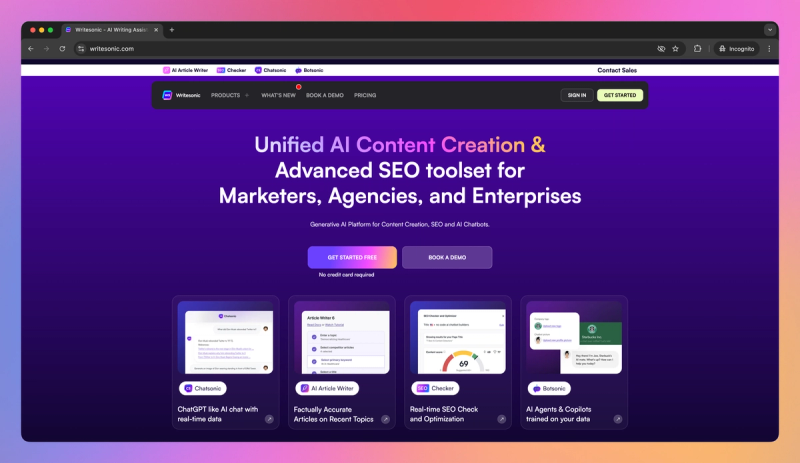
Writesonic
Writesonic has quickly become one of the most popular AI content generators, distinguished by its speed, flexibility, and SEO focus. It offers a suite of tools for generating blog posts, marketing copy, and even AI images, but its hallmark is an AI Article Writer that can produce long-form blog drafts rapidly. This tool caters to a broad base – from novice bloggers to experienced SEO content teams – by providing an easy interface with powerful options, including the ability to select different AI quality modes. Its core value lies in delivering quality content fast while giving you control over the AI output, making it ideal if you need quick turnaround without sacrificing too much quality, such as for content marketing on tight deadlines or managing your own content.
Pros:
- User-Friendly: The interface is straightforward, allowing even first-time creators to generate blog content quickly with a minimal learning curve. You can get started within minutes of signing up.
- High-Quality Output: Content generated, especially on higher settings, often requires only light editing and produces well-structured, SEO-friendly drafts that sound quite human, saving considerable time.
- Great Value: Compared to competitors, it offers a generous free trial and affordable plans with options to balance cost and quality, making it attractive for freelancers and small businesses.
Cons:
- Content Limits: Free and lower-tier plans have word or generation caps, which can be restrictive for very long articles or high-volume needs, potentially requiring plan upgrades or credit purchases.
- Repetitive Phrasing: Outputs can sometimes include repetitive filler phrases or overly formal language, necessitating editing to ensure originality and remove redundancy, especially in longer drafts.
- Occasional Inaccuracy: While it has features to check facts using real-time data, the AI can still produce outdated or incorrect information if these checks aren't actively used, requiring oversight for factual content.
Best Use Cases:
- Fast-Paced Content Marketing: Ideal for bloggers and SEO writers needing regular article production, quickly generating SEO-rich first drafts for blogs, listicles, and website content.
- Small Businesses & Startups: Enables maintaining an active blog and social media presence affordably without large writing teams, covering idea generation to final draft.
- Agency Content Management: Suitable for agencies managing multiple clients, easily switching tones and formats for diverse content needs and benefiting from multi-language support.
Best AI Blog Post Generator for Iterating Marketing Copy
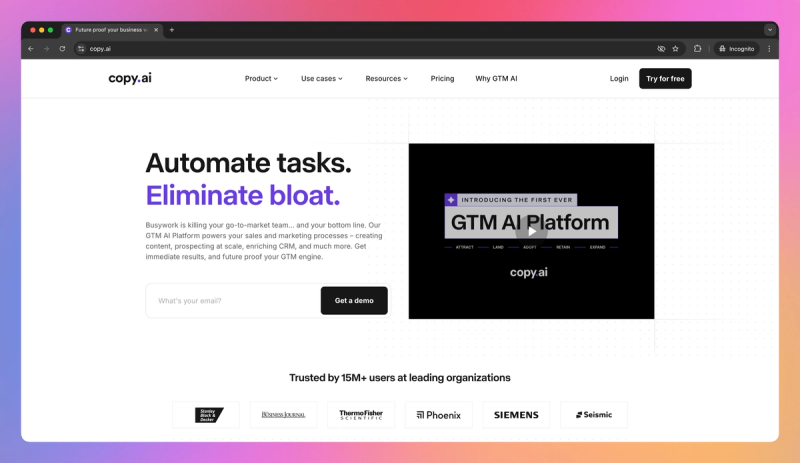
Copy.ai
Copy.ai established itself early as an approachable, marketing-focused AI writing tool, excelling particularly in short-form content like ad text and social captions, though it also supports longer blog posts via guided workflows. Its primary strength lies in a simple, iterative process that feels like brainstorming with a copy assistant, making sophisticated copywriting accessible even if you lack deep expertise. With numerous templates and a friendly interface, the platform effectively lowers the barrier to creating engaging marketing materials, positioning it as a strong option for startups, small business owners, and marketers needing efficient content creation.
Pros:
- Beginner-Friendly Interface: Its simplicity is a major draw; the minimal learning curve allows you to generate useful content almost immediately, even without prior AI tool experience.
- Excels at Short Copy: The platform shines when generating multiple variations of punchy ad copy, taglines, or social media posts quickly, providing creative options that often require little editing.
- Iterative Refinement Loop: You can efficiently polish outputs directly within the tool using follow-up prompts like "make it shorter" or "add humor," saving significant editing time compared to static generators.
- Cost-Effective Plans: Offers fair pricing, including a free tier and reasonably priced starter options, providing excellent value, especially considering the potential time savings.
Cons:
- Generic Output Risk: Longer content can sometimes include clichés or filler phrases, often requiring an editing pass to inject unique insights and remove generic language.
- Potential Inaccuracies: The AI may occasionally generate factually incorrect or irrelevant information, particularly on complex or niche topics, requiring careful fact-checking.
- Inconsistent Support: Some have reported occasional issues with customer support responsiveness or billing, which could be a drawback if you encounter urgent problems.
- Lacks Advanced Customization: Power users might find it basic, missing features like deep SEO analysis or the ability to train custom models on proprietary data found in enterprise-focused tools.
Best Use Cases:
- Marketing Campaign Assets: Quickly generate a suite of materials for product launches, including website text, taglines, social media posts, and email announcements.
- Social Media & E-commerce Content: Ideal for social media managers needing daily posts or e-commerce businesses requiring engaging product descriptions and ad copy at scale.
- Brainstorming and Initial Drafts: Excellent for overcoming writer's block by generating blog titles, introductory paragraphs, or initial ideas that you can then refine.
Best AI Blog Post Generator for Predicting Copy Performance
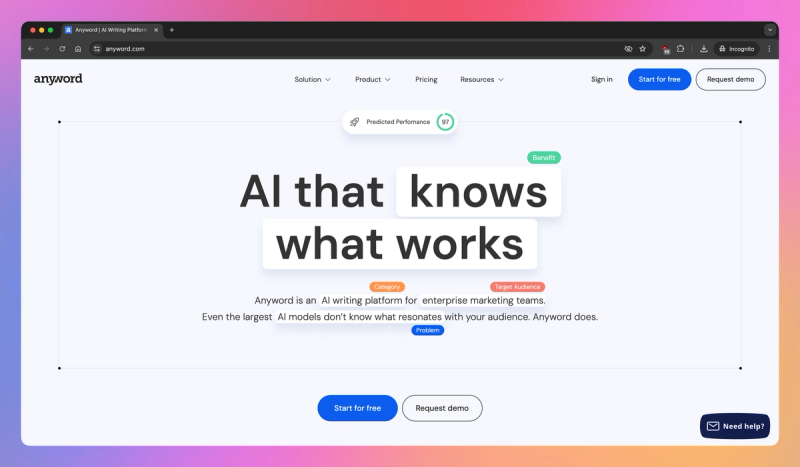
Anyword
Anyword distinguishes itself as an AI writing platform built specifically for performance-oriented marketing content, focusing on predicting how copy variants might perform with your target audience. Designed with advertisers and conversion copywriters in mind, its core value lies in optimizing messaging through data, using a model trained on millions of marketing messages to provide analytics and scores for predicted engagement. This platform integrates audience targeting through specified buyer personas or demographics, allowing copy generation tailored to specific segments like age or industry. Additionally, it offers Brand Voice customization and Brand Rules settings to enforce terminology and style guidelines, ensuring consistency and compliance across all generated content.
Pros:
- Improved Conversions: By leveraging the predictive scores to select variants, you can identify messaging that truly resonates, often leading to tangible improvements in click-through rates and campaign engagement.
- Data-Backed Confidence: The tool helps overcome writer's block not just by generating options, but by providing data scores that offer confidence in choosing the most effective copy, encouraging experimentation.
- Highly Relevant Content: Specifying target audiences and personas enables the creation of copy that feels genuinely personalized and relevant to different reader segments, boosting connection.
Cons:
- Premium Pricing: Accessing the full suite of advanced features, particularly predictive scoring and analytics feedback, comes at a higher cost compared to more generalist AI writing tools.
- Learning Curve: Fully utilizing the platform's settings, understanding predictive scores, and defining personas requires a marketing mindset and involves a steeper learning curve than simpler tools.
- Potentially Robotic Tone: The strong focus on conversion optimization can sometimes lead to outputs that feel slightly less creative or more machine-like, occasionally sacrificing a unique voice for known effective phrasing.
Best Use Cases:
- Digital Advertising Campaigns: Generating and testing multiple ad copy variations for platforms like Google Ads or Facebook to identify top performers based on predicted engagement scores.
- Landing Page and Funnel Optimization: Crafting headlines, call-to-action phrases, and body copy for landing pages with the highest predicted impact to boost sign-ups or sales conversions.
- Targeted Email Marketing: Developing subject lines and email body content optimized for specific audience segments, aiming to increase open rates and click-throughs.
Best AI Blog Post Generator for Writing Affordably

Rytr
Rytr is a popular AI writing assistant known for being simple, fast, and extremely affordable, featuring a prominent free tier that attracts many. It excels at getting decent content out quickly through a minimalistic interface; you simply choose a language, tone, and a use-case from over 30 templates like Blog Idea or Product Description, provide some context, and get results fast. This tool supports over 30 languages and includes a rich text editor, allowing you to format outputs or compose longer pieces section by section. While aimed at individuals, basic team features enable project organization and shared credits, offering a versatile writing co-pilot for everyday tasks.
Pros:
- Affordability: You really can't beat the price-to-value ratio here. With a functional free plan and very inexpensive paid options, it makes AI writing accessible without a significant budget commitment.
- Simplicity and Speed: The platform is incredibly easy to navigate, requiring almost no learning curve. You can generate content snippets or ideas in seconds, making it perfect for quick tasks and overcoming writer's block.
- Multi-Language Capabilities: Support for over 30 languages is a major advantage if you need to create content for global audiences or require assistance in languages other than English.
Cons:
- Limited Advanced Features: If you need deep customization, SEO analysis, predictive scoring, or integration with specific knowledge bases, this tool will likely feel too basic as it lacks these higher-end capabilities.
- Output Length & Credit Limits: The free plan's character limits are quite restrictive for regular use. Generating longer articles requires piecing together smaller chunks, which can be less convenient than dedicated long-form generators.
- Inconsistent Quality: While great for straightforward tasks, the output quality for more complex or nuanced topics can be hit-or-miss, often producing generic text that needs significant editing for uniqueness and depth.
Best Use Cases:
- Individuals & Small Teams: Perfect if you're a solo creator, student, or part of a small team needing quick drafts for social media posts, simple blog sections, product descriptions, or email responses without high costs.
- Routine Writing & Brainstorming: Excellent for generating initial ideas, outlining content, or handling repetitive writing tasks like drafting standard emails or thank-you notes, effectively relieving the pressure of staring at a blank page.
Best AI Blog Post Generator for Governing Enterprise Content

Writer
Writer is a comprehensive generative AI platform specifically designed for businesses, especially mid-size to enterprise organizations that prioritize control, security, and brand consistency in their content. It functions as more than just a generator; it's a full writing assistant integrating into workflows, enforcing style guides, and leveraging internal company knowledge through custom-trained AI models and a Knowledge Graph feature connected to internal data sources. This platform emphasizes robust admin controls, data privacy (claiming customer data isn't used for external model training), and compliance features like SOC 2, SSO, and options for private deployment, aiming to provide AI capabilities that meet stringent corporate IT and legal standards. Its goal is to empower teams across an organization to produce content that is consistently accurate, on-brand, and compliant.
Pros:
- Consistency and Brand Integrity: Writer acts like a vigilant copyeditor, ensuring all content aligns with brand standards, voice, and terminology using customizable style guides and AI guardrails, reducing the need for extensive manual reviews.
- Cross-Department Productivity: By integrating with tools like Chrome, Google Workspace, and Microsoft Office, Writer boosts efficiency not just for content teams but also for support, HR, sales, and legal departments, streamlining tasks like drafting emails, policies, or knowledge base articles.
- Enterprise Support: Writer offers strong customer success and onboarding, helping enterprises implement style guides, train models, and drive adoption, acting more like a partner than just a software vendor.
- Cost and Error Reduction: Real-time checks for grammar, style, jargon, and compliance help reduce errors, minimize revision rounds, and cut down on external editing costs or potential compliance issues.
Cons:
- Learning Curve and Setup: Implementing Writer effectively requires upfront effort to configure style guides, potentially train custom models, and onboard teams, meaning time is needed before realizing full benefits.
- Less Suited for High Creativity: The platform's focus on consistency and compliance might make it less ideal for highly creative or imaginative writing tasks compared to more open-ended AI tools.
- Premium Pricing: Positioned for the enterprise market, Writer's per-seat and often custom pricing is higher than many general AI writers, making it potentially too costly for individuals or small businesses.
- Potential Output Limitations: Adherence to strict style guides can sometimes result in AI suggestions that are brief or less creative than general models; its specialized nature might trade off some breadth for depth on company-specific topics.
Best Use Cases:
- Enterprise Content Marketing: Ensures consistency across blogs, ebooks, and social content created by multiple writers, speeding up drafting while maintaining brand voice.
- Customer Support & Knowledge Management: Helps draft accurate, on-brand knowledge base articles and agent responses by leveraging internal data and approved language.
- Regulated Industries: Assists healthcare, finance, or insurance companies in creating compliant, clear communications by enforcing specific rules and disclaimers.
Best AI Blog Post Generator for E-commerce Content
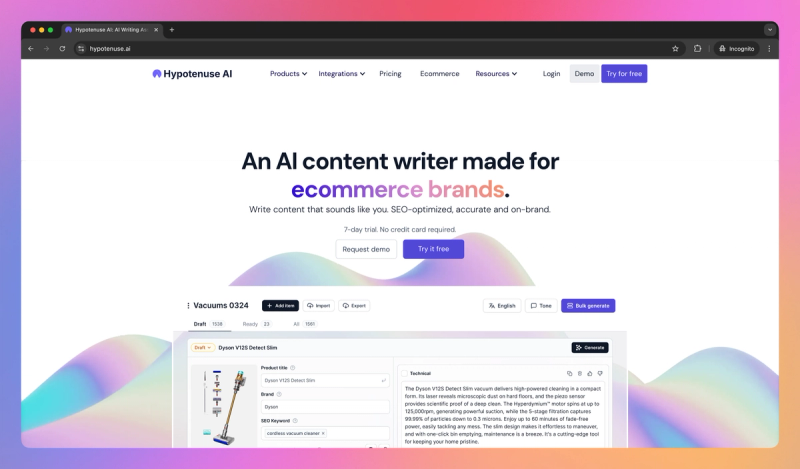
Hypotenuse AI
Overview
Hypotenuse AI is an AI writing tool laser-focused on the needs of e-commerce businesses and product-focused content creation. While it can produce general blog posts or marketing copy, its standout strength lies in generating product descriptions, category page content, and ad copy specifically tailored to drive online sales. The platform aims to help online retailers and brands create high-converting, SEO-optimized product content at scale, handling work that might otherwise demand extensive copywriting resources. It also covers related content like promotional emails and social ads for products, developing into an all-in-one platform with features extending to product data enrichment and even image editing for e-commerce needs. If you sell products online and need a high volume of descriptive and promotional content, this tool is designed for your requirements.
Pros:
- Significant Time Savings: You can reduce the time spent writing product descriptions from weeks to mere hours, which is especially beneficial for large inventories or new collection launches.
- Conversion-Optimized Copy: The generated content focuses on highlighting selling points and uses persuasive language designed to turn page views into actual sales.
- E-commerce Specialization: The tool demonstrates a deep understanding of e-commerce needs, producing relevant and effective copy that uses appropriate terminology and tone for online retail.
Cons:
- Busy Interface: The dashboard presents many options and data points, which can feel overwhelming and introduce a slight learning curve.
- Limited Outside E-commerce: If your content needs extend significantly beyond product descriptions and online retail, you might find its specialized focus less beneficial than a generalist tool.
- Cost at Scale: While cost-effective compared to manual copywriting, the subscription cost for very high volumes can be substantial, making it most suitable for businesses with ongoing large-scale content needs.
Best Use Cases:
- Scaling Product Descriptions: Ideal for online retailers or brands needing to generate unique, SEO-friendly descriptions for large numbers of products quickly.
- E-commerce Content Marketing: Creating supporting blog content, buying guides, or promotional emails that effectively feature and link to products.
- Agency E-commerce Services: Agencies serving multiple online retail clients can efficiently produce tailored product copy and marketing materials at scale.
Best AI Blog Post Generator for Scaling SEO Content Production
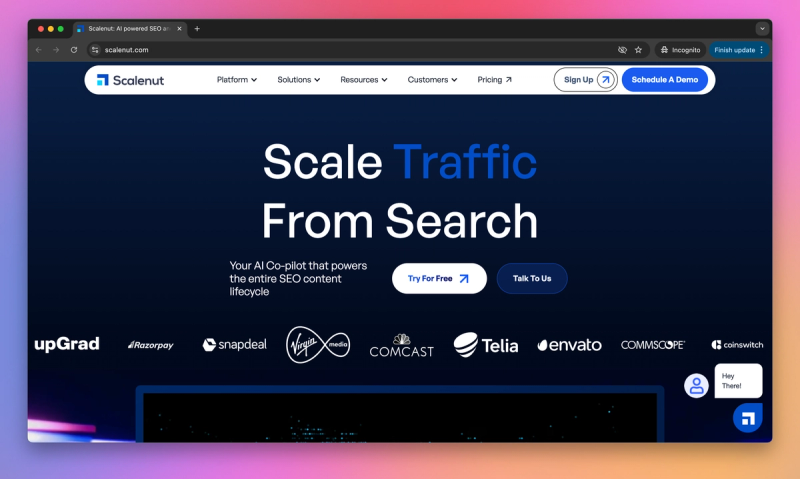
Scalenut
Scalenut is an AI-powered content research and writing platform designed for SEO professionals and content marketers aiming to create content that ranks well on search engines. Unlike a generic AI writer, Scalenut combines AI writing capabilities with in-depth SEO insights—including topic research, competitor analysis, and keyword planning—all within one tool. The goal is to scale content output without sacrificing quality or search optimization. It’s often positioned as an alternative to using separate tools for SEO analysis, AI writing, and keyword research, attempting to integrate the entire workflow. If you need to produce a content cluster around a topic, Scalenut assists from planning (identifying subtopics and keywords) through writing (AI draft generation) to optimization (fine-tuning content with NLP and SERP data). This integrated approach makes it particularly appealing for agencies, SEO content teams, and growth startups focused on systematically increasing organic traffic.
Pros:
- Comprehensive Solution: Reduces the need for multiple tools by rolling keyword research, AI writing, and SEO checking into one platform, saving subscription costs and streamlining the content pipeline.
- Improved Search Rankings: Helps create content that satisfies search intent thoroughly by covering relevant subtopics and keywords, leading to higher rankings and more organic traffic according to user reports.
- User-Friendly Design: Despite its feature depth, the interface guides you step-by-step, making complex SEO tasks manageable even without deep expertise, especially with modes like Cruise Mode.
- Continuous Improvement: The platform evolves quickly, adding new features and responding to SEO trends and user feedback, ensuring the tool stays cutting-edge.
Cons:
- Requires SEO Knowledge: While helpful, fully leveraging its potential requires understanding SEO concepts; beginners might find some features underutilized or confusing without this context.
- Formulaic Content Quality: The heavy guidance from SEO data can sometimes lead to content outputs that feel formulaic or lack unique creative flair, often requiring editing for voice and readability.
- Cluttered Interface: The all-in-one nature means many panels and data points are visible, which can feel overwhelming or distracting if you prefer a simpler writing environment.
- Higher Cost for Casual Use: Pricing is geared towards value for SEO-focused, high-volume content production, making it potentially expensive if you only write articles occasionally.
Best Use Cases:
- Scaling SEO Content: Ideal for niche site operators, affiliate marketers, or agencies needing to produce many SEO-optimized articles targeting various keywords systematically.
- Building Content Hubs: Great for in-house marketing teams aiming to capture organic traffic by building comprehensive content hubs or knowledge bases planned around keyword clusters.
- Refreshing Existing Content: Useful for inputting older articles, analyzing competitor changes, and implementing updates to regain SEO competitiveness.
Conclusion
AI blog post generators have matured into specialized tools that serve distinct content creation needs - from enterprise governance to e-commerce copy. They demonstrably reduce content production time while maintaining quality when used strategically. For businesses willing to invest time in proper setup and oversight, these tools offer a clear path to more efficient, consistent content creation.





